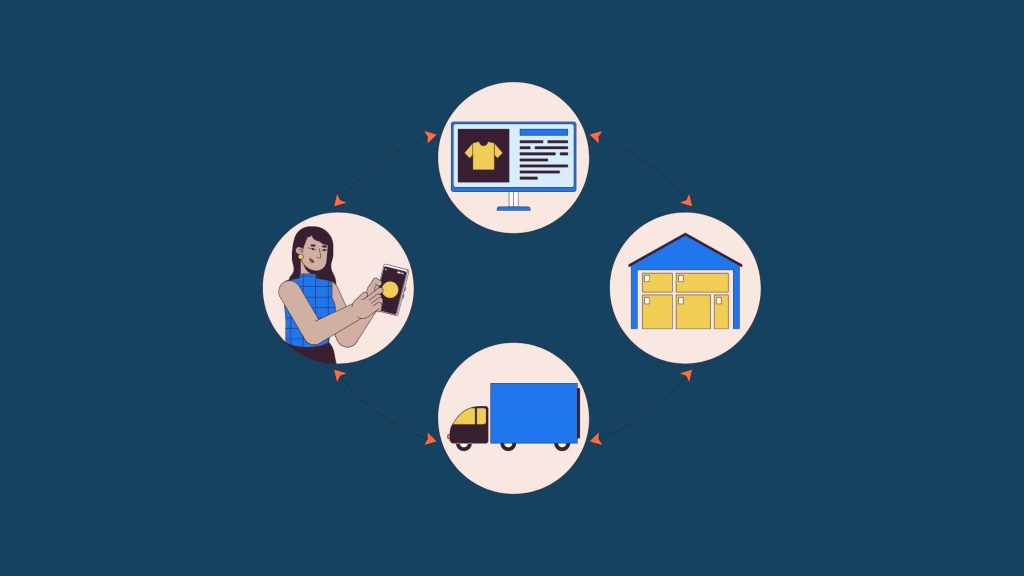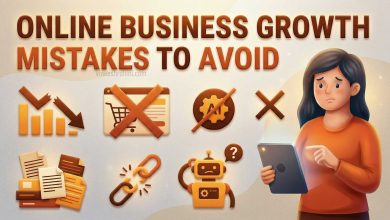How To Start Dropshipping Business In India – Comprehensive Guide 2024
How To Start Dropshipping Business : Dropshipping is a popular e-commerce business model that has gained significant traction globally, including in India. It allows entrepreneurs to start an online business without the need to maintain inventory or handle the shipping process. Instead, when a customer places an order, the retailer (dropshipper) purchases the product from a third-party supplier, who then ships the item directly to the customer. The dropshipper makes a profit by selling the product at a higher price than the supplier’s cost.
Table of Contents
The appeal of dropshipping lies in its low barrier to entry, as you don’t need a warehouse or large capital to start. India, with its growing internet penetration, increasing online consumer base, and supportive digital infrastructure, offers an exciting opportunity for aspiring entrepreneurs to launch a dropshipping business.
Also Read : How to Start Affiliate Marketing in India : A Comprehensive Guide – 2025
This detailed guide will walk you through the process of starting a dropshipping business in India, discussing everything from understanding the business model to scaling it for success.
What is Dropshipping?

Dropshipping is a retail fulfillment method where the store does not keep the products it sells in stock. Instead, the store owner (you) partners with suppliers who manage the inventory and ship products directly to customers. Here’s how the dropshipping process works:
- Customer places an order on your e-commerce store.
- You forward the order to the supplier, who prepares and ships the product to the customer.
- You profit from the price difference between what the customer paid and what you pay to the supplier.
Unlike traditional retail businesses, you don’t need to purchase products upfront or manage inventory. Your role is to market the products, manage the website, and handle customer service, while the supplier takes care of stock and delivery.
Why Start a Dropshipping Business in India?
India presents a fertile ground for the dropshipping business for several reasons:
- Low Startup Cost: Since dropshipping doesn’t require you to purchase inventory upfront, it’s a cost-effective way to start an e-commerce business. You can launch your online store with minimal investment, focusing on website development and marketing.
- Growing E-commerce Industry: India’s e-commerce industry is booming, with millions of consumers shopping online. As of 2024, the industry is expected to reach $200 billion, making it a lucrative market for new online businesses.
- Wide Product Variety: India’s diverse consumer base has a high demand for various product categories, from fashion and beauty products to electronics and home goods. This variety opens up opportunities for dropshippers to cater to different niches.
- Supplier Access: India has access to global suppliers from platforms like AliExpress, GlowRoad, and Oberlo, making it easy to find affordable products to sell. Additionally, local Indian suppliers are also adopting dropshipping models, offering quicker shipping times and lower costs.
- Flexible Work Model: Dropshipping can be managed from anywhere, providing flexibility to work from home and manage your business part-time or full-time.
Step-by-Step Guide to Starting a Dropshipping Business in India

1. Choose a Niche
The first step in launching a dropshipping business is selecting a niche. A niche refers to a specific product category that targets a particular group of customers. Choosing the right niche is crucial for your success because it defines the type of products you will sell, your target audience, and your marketing strategy.
Consider the following when choosing your niche:
- Passion and Interest: Select a niche that you are genuinely interested in. Passion for the products you sell will keep you motivated and help you better understand your customers.
- Market Demand: Research market trends and consumer demand to identify profitable niches. Use tools like Google Trends, Amazon Best Sellers, and keyword research tools to find in-demand products.
- Competition: While it’s essential to choose a niche with demand, avoid oversaturated markets. Entering a niche with high competition can make it harder to stand out.
- Profit Margins: Ensure that the products in your niche offer healthy profit margins. After factoring in product costs, shipping fees, and marketing expenses, you should still have room for profit.
Popular dropshipping niches in India include fashion apparel, mobile accessories, beauty products, home décor, and fitness equipment.
2. Find Reliable Suppliers
Once you’ve chosen a niche, the next step is to find reliable suppliers who will fulfill your orders. The success of your dropshipping business depends heavily on the quality of your suppliers. Look for suppliers who offer competitive prices, quality products, and reliable shipping services.
Some popular dropshipping supplier platforms for Indian entrepreneurs include:
- AliExpress: A global platform that offers millions of products at affordable prices. AliExpress suppliers ship worldwide, making it a great option for Indian dropshippers targeting both domestic and international customers.
- GlowRoad: This Indian platform specializes in dropshipping, offering products from local suppliers with faster shipping times within India.
- Oberlo: Oberlo is another dropshipping platform that integrates with Shopify, offering access to a large selection of products.
When choosing a supplier, consider factors like:
- Product quality: Ensure that the supplier offers high-quality products by checking reviews and ratings from other dropshippers.
- Shipping times: Shipping speed is crucial for customer satisfaction. Look for suppliers who offer reasonable delivery times, especially if you’re targeting Indian customers.
- Return policy: Understand the supplier’s return and refund policies to manage customer service effectively.
Building a strong relationship with your supplier is key to ensuring smooth order fulfillment and avoiding issues like stockouts or delayed shipping.
3. Create Your Online Store
Now that you have a niche and suppliers, it’s time to create your online store. Your e-commerce store is where customers will browse and purchase products, so it’s essential to create a user-friendly and professional website.
Here’s how to set up your online store:
- Choose an E-commerce Platform: Select a platform that supports dropshipping and allows easy integration with suppliers. Popular e-commerce platforms for dropshipping include:
- Shopify: Shopify is a user-friendly platform designed for e-commerce businesses. It offers a wide range of features, including inventory management, payment processing, and easy integration with dropshipping apps like Oberlo.
- WooCommerce: If you prefer using WordPress, WooCommerce is a free plugin that turns your website into an e-commerce store. It’s highly customizable and integrates with various dropshipping tools.
- Wix: Wix is another user-friendly platform with drag-and-drop features, ideal for building a dropshipping store without any coding knowledge.
- Design Your Store: Choose a clean and responsive design that enhances the user experience. Ensure your website is easy to navigate, mobile-friendly, and optimized for quick loading times. You can use pre-designed templates or hire a web designer to create a custom look.
- Set Up Product Pages: Create individual product pages for each item you plan to sell. Write detailed product descriptions that highlight the features and benefits of the product. Include high-quality images and videos to make the product more appealing to potential buyers.
- Payment Gateway: Set up a payment gateway to accept online payments. Popular payment gateways in India include Razorpay, Paytm, and Instamojo, which support multiple payment methods such as credit/debit cards, UPI, and net banking.
4. Price Your Products
Setting the right price for your products is crucial for the success of your dropshipping business. Since you’ll be sourcing products from suppliers, your profit will come from the markup you apply to the supplier’s cost. However, pricing too high may drive away potential customers, while pricing too low may hurt your profit margins.
Consider the following when pricing your products:
- Cost of Goods Sold (COGS): This includes the price you pay to your supplier for the product, along with any shipping fees and transaction costs.
- Market Competition: Research the prices set by your competitors and aim to offer competitive prices that still allow you to make a profit.
- Profit Margin: A good rule of thumb is to aim for a profit margin of 30% to 50%, depending on the product category. This means that if you purchase a product for ₹1,000, you should aim to sell it for ₹1,300 to ₹1,500 to cover expenses and make a profit.
5. Market Your Dropshipping Business
Marketing is the key to attracting customers to your online store. Without effective marketing, even the best-designed website won’t generate sales. Here are some effective marketing strategies to promote your dropshipping business:
- Search Engine Optimization (SEO): Optimize your website for search engines like Google. Use relevant keywords in your product descriptions, meta tags, and blog content to rank higher in search results and attract organic traffic.
- Social Media Marketing: Utilize platforms like Facebook, Instagram, and Pinterest to promote your products. You can run paid ads on these platforms to reach a larger audience or post engaging content to build a loyal following.
- Google Ads: Google Ads allows you to run pay-per-click (PPC) campaigns that appear in Google search results. This can help you attract potential customers actively searching for the products you offer.
- Email Marketing: Build an email list of potential customers and send them newsletters, promotions, and product updates. Email marketing is an excellent way to maintain customer engagement and increase repeat sales.
- Influencer Marketing: Collaborate with influencers in your niche to promote your products. Influencers can help you reach a targeted audience and build trust with potential customers.
- Referral Programs: Offer incentives for existing customers to refer their friends and family to your store. This can help you generate word-of-mouth marketing and increase your customer base.
6. Manage Customer Service and Fulfillment
As a dropshipper, your primary responsibility is to manage customer service and ensure smooth order fulfillment. While the supplier handles the logistics, you must communicate with customers, resolve issues, and ensure they have a positive shopping experience.
Here’s how to manage customer service effectively:
- Clear Communication: Keep customers informed about their order status, including confirmation, shipping updates, and estimated delivery times.
- Easy Returns and Refunds: Have a straightforward return and refund policy in place. Ensure that customers can easily return products if they’re unsatisfied and process refunds promptly.
- Resolve Issues: If a customer encounters any issues with their order (e.g., damaged product, wrong item), act swiftly to resolve the problem. Communicate with your supplier to arrange replacements or refunds as needed.
Good customer service is crucial for building trust and encouraging repeat purchases. A satisfied customer is more likely to recommend your store to others and become a loyal customer.
Legal and Financial Aspects of Dropshipping in India

Starting a dropshipping business in India involves several legal and financial considerations. To ensure your business operates smoothly and complies with regulations, take the following steps:
1. Register Your Business
While you can start a dropshipping business as an individual, it’s recommended to register your business to avoid legal complications and build trust with suppliers and customers. You can register your dropshipping business as:
- Sole Proprietorship: This is the simplest form of business registration, ideal for small businesses. You can operate under your name or a business name (e.g., ABC Enterprises).
- Private Limited Company (PLC): If you plan to scale your business and seek external investment, you can register as a Private Limited Company. This structure offers limited liability protection and allows you to raise capital from investors.
2. Get a GST Registration
Goods and Services Tax (GST) is mandatory for e-commerce businesses in India. To comply with tax regulations, you must register for GST and charge it on sales made through your online store. You can apply for GST registration online through the GST portal.
3. Set Up a Business Bank Account
Open a separate business bank account to manage your finances and track expenses. This helps you maintain clear financial records and simplifies tax filing.
4. Income Tax Filing
As a business owner, you’ll be required to file income tax returns on the profits you earn from your dropshipping business. Maintain detailed financial records and consult with a tax advisor to ensure compliance with tax laws.
Scaling Your Dropshipping Business

Once your dropshipping business is up and running, the next step is to focus on scaling it. Scaling involves growing your business by increasing sales, expanding your product range, and optimizing your operations.
Here’s how to scale your dropshipping business:
- Expand Your Product Range: Once you’ve established a customer base, consider expanding your product range by adding complementary products or exploring new niches.
- Invest in Paid Advertising: Increase your marketing budget to run more targeted ads on platforms like Google and Facebook. Experiment with different ad formats, such as video ads, carousel ads, and remarketing campaigns, to drive more traffic to your store.
- Automate Operations: As your business grows, you’ll need to automate repetitive tasks to save time. Use tools and software to automate order processing, inventory management, and email marketing.
- Improve Website Performance: Invest in website optimization to ensure fast loading times and a seamless user experience. A well-optimized website can lead to higher conversion rates and increased sales.
- Optimize for Mobile: With the growing number of mobile users in India, ensure your website is fully optimized for mobile devices. A mobile-friendly store improves the shopping experience for customers and boosts your search engine rankings.
- Focus on Customer Retention: It’s more cost-effective to retain existing customers than acquire new ones. Offer loyalty programs, personalized recommendations, and exclusive discounts to encourage repeat purchases.
- Expand Internationally: Once you’ve established a strong presence in India, consider expanding your business to international markets. Partner with global suppliers and offer international shipping to tap into new customer segments.
How To Start Dropshipping Business : Conclusion

Starting a dropshipping business in India is a lucrative opportunity for aspiring entrepreneurs. With low startup costs, minimal risk, and the potential to reach millions of online shoppers, dropshipping offers a flexible and scalable business model. By choosing the right niche, partnering with reliable suppliers, building a professional online store, and implementing effective marketing strategies, you can create a successful dropshipping business that thrives in India’s rapidly growing e-commerce market.
Buy Now : Ecommerce Website With 100 Products
While dropshipping is an excellent option for beginners, success doesn’t happen overnight. It requires consistent effort, good customer service, and strategic planning. As your business grows, focus on scaling and optimizing operations to maximize profits and achieve long-term success.
Keywords : How To Start Dropshipping Business – How To Start Dropshipping Business 2024 – How To Start Dropshipping Business 2025 , How To Start Dropshipping Business In India , How To Start Dropshipping Business In India 2025 , How To Start Dropshipping Business Now , How To Start Dropshipping Business For You , How To Start Dropshipping Business Here



